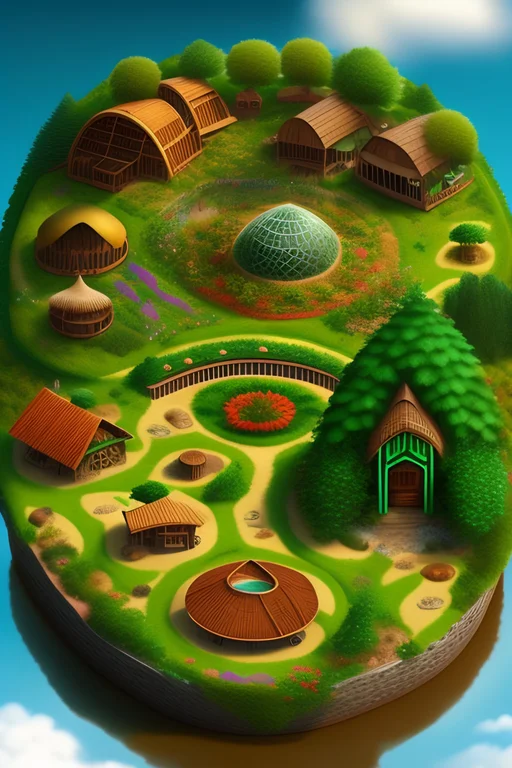Let’s Begin with the Basics: Defining Permaculture
Imagine awakening to a symphony of birdsong, sipping your morning brew in a lush garden that pretty much takes care of itself. Verdant vines heavy with ripe tomatoes wind around trellises, bees hum around blossoms, and a clucking chicken pecks the ground nearby. Sounds like paradise, right? So what is permaculture? This is the world of permaculture.
Permaculture, a portmanteau of “permanent culture,” is an agricultural and social design principle centered around simulating or directly utilizing patterns and resilient features observed in natural ecosystems. If that’s too much jargon, let me simplify it: it’s about designing human systems (like farms or cities) that mimic nature, so they’re sustainable, diverse, resilient, and beautiful. It’s like playing “Simon Says” with Mother Nature. And when Mother Nature is Simon, you’re sure to win!
What is Permaculture: The Ethics of Permaculture
In permaculture, we don’t just dive headfirst into the dirt (although that can be fun too!). We start with a solid ethical foundation, a kind of ‘triforce’ if you will. Permaculture’s triforce consists of Earth Care, People Care, and Fair Share. These three ethics form the cornerstone of all we do in permaculture.
Earth Care
Earth Care is about recognizing that we’re not landlords, but tenants on this beautiful blue marble. We strive to protect our environment, conserve resources, and support all forms of life.
People Care
On to the next piece of our triforce, People Care. While we love our worms and bees, we mustn’t forget our own species. People Care involves creating environments and systems that provide for our needs but also nourish us physically, emotionally, and spiritually.
Fair Share
Last, but certainly not least, we have Fair Share. This principle is about redistributing the surplus to support Earth Care and People Care. It’s about giving back, not just taking. It’s realizing that if life were a bakery, Mother Nature is the best pastry chef, and her delights are for everyone to enjoy.
What is Permaculture: The Elements of Permaculture
Permaculture isn’t just a patch of greens; it’s an ecosystem, a living, breathing entity where every element has a role to play.
Plants and Trees
In a permaculture system, plants and trees are the rock stars. They’re not only for decoration or food production; they have far more critical roles. They help build healthy soil, manage water, provide habitat for beneficial creatures, and create a microclimate.
Animals
In this natural orchestra, animals are the percussion, maintaining the rhythm. Chickens, ducks, goats, or bees are not only food providers; they help manage pests, cycle nutrients, and assist in seed dispersal.
Water and Soil Management
Water and soil might seem like the roadies in this grand concert, but they’re the unsung heroes. Healthy soil is the lifeblood of any garden, and permaculture emphasizes improving and preserving soil health. Similarly, managing water wisely, reducing runoff, and maximizing infiltration are key components of a permaculture design.
Permaculture Principles: Nature’s Teachings
Permaculture isn’t just about mimicking nature; it’s also about learning from it. There are several permaculture principles, each drawn from nature’s infinite wisdom, like “use edges and value the marginal” or “creatively use and respond to change”. These principles guide us in designing systems that are resilient and sustainable.
What is Permaculture: Benefits of Permaculture
One thing’s for sure – permaculture isn’t just about getting your hands dirty. It’s about diving headfirst into a myriad of benefits that positively impact both people and the planet. Let’s dig into some of these benefits.
Sustainable Agriculture
First and foremost, permaculture promotes sustainable agriculture. It allows us to grow our food in a way that doesn’t deplete the earth’s resources or damage the environment. It’s like borrowing a book from a library – we use it, then return it in the same (if not better) condition for others to use. This way, we ensure that future generations can continue to reap the bountiful harvest that Mother Earth provides.
Climate Change Mitigation
Permaculture practices help mitigate climate change by sequestering carbon, restoring degraded lands, and promoting sustainable lifestyles. By creating food forests, building soil health, and using renewable resources, we’re not just reducing our carbon footprint, but we’re also actively pulling carbon out of the atmosphere and locking it into the soil. Talk about taking a bite out of climate change!
Biodiversity Boost
Permaculture designs often resemble natural ecosystems, which are inherently diverse. This diversity helps build resilience against pests, diseases, and climate fluctuations. And it doesn’t stop at plant diversity. A permaculture garden is buzzing with life, from the microorganisms in the soil to the birds in the trees. It’s a biodiversity hotspot right in your backyard!
Health and Wellbeing
Growing your food isn’t just good for the planet; it’s good for you too! Fresh, organic produce right from your garden is not only bursting with nutrients but also devoid of harmful chemicals often found in commercially grown foods. Plus, the act of gardening itself is a fantastic way to stay active and reduce stress. It’s like a gym membership and therapy session all in one, except it’s free and comes with tomatoes!
Building Communities
And let’s not forget the community aspect. Permaculture brings people together. Community gardens provide a space to connect with your neighbors, share knowledge and resources, and foster a sense of belonging. It’s about nurturing not just plants, but relationships too.
In the end, the benefits of permaculture extend far beyond he garden. It’s a holistic approach that enhances the health of our planet, our communities, and ourselves. Now, isn’t that worth getting your hands dirty for?
From Theory to Practice: Starting Your Permaculture Journey
So, you’ve had a taste of what permaculture is all about, and you’re ready to roll up your sleeves and jump into the deep end. But where do you start? How do you transform your conventional garden, or even a barren piece of land, into a thriving permaculture paradise? Let’s dive into some practical tips to kick-start your permaculture journey.
Observation is Key
The first step in your permaculture journey should be to observe. Understanding your local climate, soil type, water flow, and wildlife can help you design a system that works with your natural surroundings, not against them. Watch where the sun rises and sets, note where water collects after rain, and observe the wildlife that visits your plot. All these can offer valuable insights for your design. Remember, patience is a virtue, especially in permaculture!
Start Small and Expand Gradually
Rome wasn’t built in a day, and neither will your permaculture garden. Start small – a herb spiral near your kitchen door, a small vegetable bed, a compost pile. As you gain confidence and experience, you can gradually expand your efforts. This approach will not only be manageable but will also allow you to learn from your successes and failures (which are inevitable, by the way!).
Build Healthy Soil
In permaculture, the soil is king. Building healthy soil is crucial for a thriving garden. Start composting your kitchen scraps, make a worm bin, or try your hand at making compost tea. These practices will recycle nutrients, improve soil structure, and increase the soil’s water-holding capacity. Healthy soil equals healthy plants!
Plant Perennials
Perennial plants, which live for many years, are a great addition to a permaculture garden. Once established, they require minimal maintenance but provide a yield year after year. Think fruit trees, berry bushes, asparagus, artichokes, and herbs like rosemary and thyme.
Encourage Beneficial Wildlife
Invite beneficial wildlife to your garden. Bees and butterflies can pollinate your plants, ladybugs and spiders can keep pests in check, and birds can help spread seeds. You can attract these critters by providing food, water, shelter, and places to breed.
Learn From Others
Join a local permaculture group, participate in a permaculture design course, or volunteer at a permaculture farm. These can provide a wealth of knowledge and inspiration, and you might meet some like-minded people along the way!
Embrace Mistakes
Lastly, remember that mistakes are part of the journey. Don’t be disheartened if things don’t go as planned. Learn from your mistakes and keep trying. Permaculture is a process, not an end result.
Embarking on a permaculture journey can be both exciting and overwhelming. But with patience, curiosity, and a willingness to get your hands dirty, you can transform your garden, and maybe even your life, through permaculture. Are you ready to step onto this path to sustainability?
What is Permaculture: The Deep Roots
Permaculture didn’t just sprout out of the ground one fine morning. It was carefully cultivated by two forward-thinking Australians, Bill Mollison and David Holmgren. In the 1970s, when bell-bottom jeans were all the rage and disco was on every radio, they dreamed up a farming system that would work with nature, not against it. They envisioned a ‘permanent agriculture’ – one that would be sustainable, respectful to Mother Earth, and resilient, just like natural ecosystems. And so, permaculture was born, and it quickly spread its tendrils across the globe.
Permaculture Principles: The Heart of the Matter
At the heart of permaculture are its principles. These aren’t a strict set of rules to be followed, but more like guidelines to help us design sustainable and resilient systems. These principles help to mimic nature’s patterns and cycles, capturing and storing energy, producing no waste, and promoting diversity. So, when we apply these principles, we’re essentially taking a leaf out of nature’s book (quite literally!).
Permaculture’s Toolbox: Techniques and Methods
Permaculture isn’t a one-size-fits-all kinda deal. It offers a vast toolbox of techniques and methods that can be mixed and matched depending on the local environment and the gardener’s needs. From companion planting, where different plants are grown together for mutual benefit (like the classic ‘Three Sisters combo of corn, beans, and squash) to aquaponics, where fish and plants live in a happy, symbiotic relationship; from ‘lasagna gardening’, a no-dig method of layering organic materials to build rich soil, to ‘hugelkultur’, where rotting wood is used as the foundation for raised garden beds. And these are just a few of the techniques in the permaculture playbook!
Permaculture Around the Globe: A Worldwide Movement
Permaculture isn’t just an Australian thing. It has blossomed into a worldwide movement, sprouting up in every nook and cranny of our planet. Let’s take a whistle-stop tour of permaculture practices around the globe.
USA
In the USA, permaculture has found a fertile ground in both urban and rural settings. From rooftop gardens in bustling cities to vast permaculture farms in the countryside, it’s changing the way America grows food. The Bullock Brothers Homestead in Washington State is a shining example of permaculture done right. Over the past 40 years, this 8-acre plot has been transformed into a thriving ecosystem.
UK
Across the pond, the UK is also embracing permaculture with open arms. Forest gardens, a key permaculture principle, are especially popular. The Agroforestry Research Trust’s forest garden in Devon is a prime example. Here, hundreds of edible and useful plants grow in a system that mimics a young natural woodland.
India
In India, permaculture is helping farmers to escape the vicious cycle of debt and environmental degradation caused by industrial agriculture. Aranya Agricultural Alternatives, a NGO in Telangana, has been spearheading the permaculture movement in India, transforming barren lands into lush farms.
Zimbabwe
Zimbabwe’s Chikukwa villages are a beacon of hope for permaculture in Africa. These villages have transformed 7000 hectares of eroded land into fertile, productive farmland using permaculture principles, proving that permaculture can be the key to food security and rural development in Africa.
Permaculture’s Triumphs and Challenges
Permaculture has many success stories, but it’s not without its challenges. While it has helped restore degraded lands, built resilience in communities, and promoted sustainable lifestyles, permaculture has been criticized for lacking scientific validation, being too labor-intensive, and having a steep learning curve. However, as more research is conducted and more people share their experiences, these challenges can be addressed.
What is Permaculture: Conclusion
What is Permaculture: Harmony with Nature
So, what is permaculture? At its core, permaculture is a philosophy and practice aimed at living in harmony with nature. It is not merely a method of farming or landscaping but a holistic approach that extends to all aspects of life. This design science is about creating sustainable human habitats that function as closed-loop systems, mirroring the efficiency and resilience of natural ecosystems.
A Global Movement with Deep Roots
Permaculture is also a global movement, with deep roots in indigenous knowledge and practices. Its principles have been adopted and adapted across diverse climates, cultures, and landscapes. From the arid deserts of Australia to the fertile plains of North America, permaculture’s branches reach out into every corner of our planet. This isn’t a trend but a way of life that has been nurtured by centuries of traditional wisdom.
Caring for the Earth and its Inhabitants
One of the fundamental tenets of permaculture is the ethic of care: caring for the earth and caring for people. This extends from soil regeneration and wildlife conservation to community-building and social justice. By integrating these principles into our lives, we don’t just nurture the environment but also cultivate better relationships with those around us. We create systems that are not just sustainable but also equitable.
Sharing the Surplus: The Generosity Principle
The third major ethic in permaculture is about sharing the surplus. Whether it’s excess produce from your garden or valuable skills and knowledge, the concept encourages sharing resources within the community. This ethos doesn’t just foster community cohesion; it also minimizes waste, another feather in the cap for environmental conservation.
A Beacon of Hope
In a world grappling with climate change, biodiversity loss, and environmental degradation, permaculture serves as a bright beacon of hope. It offers practical, grassroots solutions to many of the challenges we face, providing a roadmap for sustainable living in an increasingly uncertain world.
A Path for Each One of Us
Most importantly, permaculture is a path that each one of us can tread, regardless of our background, skills, or resources. Whether you’re transforming your suburban backyard or contributing to community projects, every action counts. Each of us has the power to make our own little corner of the world a better place, one sustainable choice at a time.
To sum it up, “What is permaculture?” is not just a question but a call to action. It is an invitation to each one of us to engage in a lifelong journey toward sustainability and harmony with both nature and humanity. It’s a multifaceted, deeply-rooted philosophy that addresses the urgent need for a sustainable, equitable future. And the more of us that walk this path, the brighter that future will be.
FAQs
How did permaculture start?
Permaculture originated in the 1970s as a brainchild of two Australians, Bill Mollison and David Holmgren. They envisioned a system of agriculture that would be not just sustainable but permanent. The term “permaculture” itself is a portmanteau of “permanent” and “agriculture.” What started as an idea to create resilient and sustainable agricultural systems has now expanded to encompass holistic design principles for creating sustainable human habitats. It draws upon ecological principles, indigenous knowledge, and sustainable architecture to create self-sustaining systems.
What are some permaculture techniques?
Permaculture employs a rich tapestry of techniques aimed at creating balanced and sustainable ecosystems. One popular technique is companion planting, where certain plants are grown together to benefit each other by repelling pests or enriching the soil. Aquaponics combines aquaculture and hydroponics, letting you cultivate plants and fish together in a symbiotic environment. Lasagna gardening involves layering different types of organic materials on top of each other to create rich soil without any digging. Hugelkultur is a technique where mounds of woody debris are covered with soil and used as raised beds, improving soil fertility and water retention. These are just a few examples; the realm of permaculture techniques is vast and continues to evolve.
Where is permaculture practiced?
Permaculture is a global movement with practitioners in nearly every country. It’s as diverse as the people who practice it, adapted to various climates, cultures, and landscapes. From the backyards of suburban USA to the farms of Zimbabwe and the rooftops of Indian cities, permaculture principles are being applied to tackle local environmental and social issues. Whether in educational settings, community gardens, or large-scale farms, the practice has been embraced across multiple platforms.
What are the challenges?
Despite its increasing popularity, permaculture faces several challenges. One significant issue is the lack of scientific validation for many of its methods. While there are numerous case studies and anecdotal evidence supporting permaculture techniques, mainstream scientific research is often lacking. Another challenge is the labor-intensity of some permaculture methods, which may deter people from adopting them. Finally, permaculture involves a steep learning curve. Understanding and applying its various principles effectively require a comprehensive education, often more than what conventional agricultural practices would demand.
Can permaculture help combat climate change?
Absolutely! Permaculture offers multiple pathways to mitigate the effects of climate change. Its emphasis on closed-loop, sustainable systems encourages the sequestration of carbon in soil and vegetation. By restoring degraded lands and converting traditional agriculture into more sustainable practices, permaculture contributes to a reduction in greenhouse gas emissions. Additionally, the lifestyle changes that permaculture promotes—like local food sourcing and reduced energy consumption—also play a role in combating climate change. In essence, permaculture not only adapts to our changing world but also offers solutions for slowing down the changes themselves.




